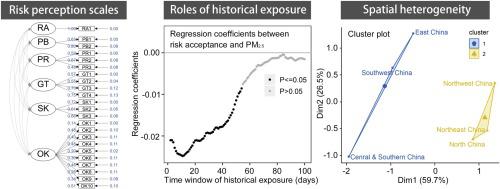Environmental Science & Policy ( IF 4.9 ) Pub Date : 2021-05-28 , DOI: 10.1016/j.envsci.2021.05.006 Qi Zhou , Nuo Chen , Xin Pan , Xue Xu , Beibei Liu , Miaomiao Liu , Jun Bi , Patrick L. Kinney

|
Psychometric paradigms have been developed and extensively applied in risk perception analyses, but relatively few studies have examined risk perception of air pollution in developing countries where the public is exposed to extremely high pollution levels. We conducted a stratified sampling questionnaire survey among 1988 college students from throughout China studying in Nanjing, to examine how risk perceptions are influenced by socioeconomic factors and historical exposure among the high-educated young generation who will become leaders in future air pollution risk management and communications. First, a six-factor confirmatory factor analysis was conducted to estimate risk perception levels from the observable indices. 40 % of the participants felt air pollution levels in Nanjing were unacceptable, which suggested that air pollution control actions do not meet public expectations at the survey time. Hierarchical k-means clustering demonstrated difference in the spatial distribution of risk perception. Results showed that students from the northern part of China had higher risk acceptance, lower perceived risk, and higher government trust than other regions. Females, older participants, participants with higher education, and participants with higher economic levels were identified as risk-sensitive groups to air pollution by using linear regression analyses. The regression coefficients of risk perception and historical exposure decreased as the days tracking back to a pollution episode increased. The cut-off point where regression coefficients turned from significant to non-significant was around 60 days for risk acceptance, 10 days for perceived benefit, and 30 days for government trust. This indicates that a 2-month time window is a prime time for risk communication after a pollution episode.











































 京公网安备 11010802027423号
京公网安备 11010802027423号